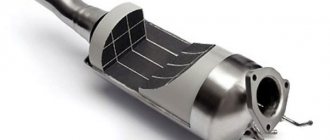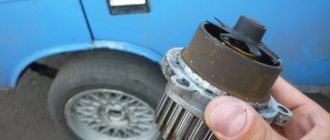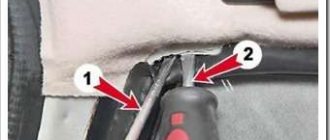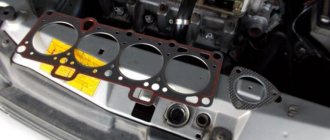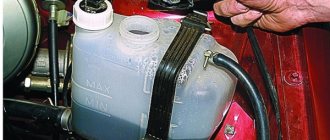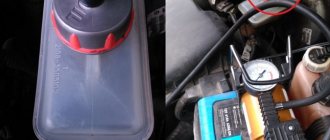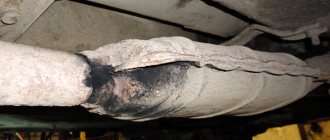Removing and installing the catalyst
Removing and installing a catalytic converter on a VAZ 2115 is a relatively simple task. The procedure itself is carried out in several stages:
1. Using keys “17”, unscrew the fastening of the catalyst to the exhaust pipe of the exhaust manifold. We take out the bolts and spring washers;
2. Place a suitable stand under the catalyst. The fact is that the catalyst on the VAZ 2115 car is not fixed with the help of any rubber hangers, and therefore, in order for it not to fall on your head, after unscrewing the fastening bolts, it must be secured somehow. This can be done either by installing a stand under it, or by temporarily securing it with wire;
3. Now unscrew the catalyst from the inlet pipe of the additional muffler and carefully remove it.
We install the new catalyst in the reverse order.
Replacing pants on a VAZ 2114
The optimal conditions for repair work will be an inspection hole, an overpass or a special lift. To work you will need:
- head and key at “13”;
- long collar;
- a flat-head screwdriver (preferably a long one).
Below is a sequential action plan:
- First of all, we move under the bottom of the car and unscrew the muffler. To do this, take the head and a 13mm wrench and unscrew the fastening hooks. Carefully move part of the muffler down.
- Now we are faced with the next task - to unscrew all four nuts securing the exhaust pipe to the exhaust manifold. We unscrew them counterclockwise. After the last fastener is unscrewed and the pipe can be moved freely, disconnect the lambda probe sensor connector from its body.
- At the third stage, we disconnect, remove and pull the exhaust pipe out.
- Using a long, flat screwdriver, pry up the old sealing gasket and remove it from the studs. We install a new one.
- We attach the pipe back. We tighten the 4 mounting bolts and tighten them.
- We connect and secure the muffler to the pipe.
What is this?
Engine overhaul refers to the work of a master aimed at returning the engine to a state as close as possible to its original state. In this case, most of the nodes are changed or restored. This type of repair is resorted to when there is a lot of wear on the parts of the unit.
The list of work may include grinding the crankshaft journal and camshaft, installing new pistons and springs, and honing the cylinders. If too many engine components are faulty, then it is more advisable to completely replace it.
The following signs indicate that it is time to overhaul the engine on the VAZ-2114:
- The appearance of red, black or dark gray carbon deposits on the spark plugs.
- Increased oil consumption.
- The occurrence of knocking in the engine.
- Increased fuel consumption.
- The appearance of smoky exhaust.
- Bad traction.
- Engine overheating.
- At idle, the engine runs unevenly.
- Reduced power.
Major repairs proceed approximately according to this scheme:
- Preparing the engine for dismantling (disconnecting wires, hoses, gearbox).
- Removing the engine.
- Removal and inspection of the cylinder head.
- Disassembling the unit for diagnostics and cleaning.
- Block boring. Grinding the crankshaft. Application of hone to the cylinder walls.
- Weight distribution of connecting rods, pistons.
- Block assembly.
- Restoring the head (replacing caps and guides, straightening seats).
- Assembling the engine and installing it in the engine compartment.
- Connection.
- Functionality check.
Cylinder head gasket VAZ 2114: features
In fact, the cylinder head gasket is a seal, that is, an element consisting of several layers. The seal can be made of reinforced flat composite sealing gasket material (paronite) or from thin sheet material with metal edging of the holes for the combustion chambers.
As mentioned above, the gasket is installed in the place where the VAZ 2114 cylinder head and the VAZ 2114 cylinder block itself are connected. During operation, this gasket experiences loads (temperature and others) and wears out. Also, given that the walls of the holes in the gasket are quite thin, this can lead to its burnout, damage and deformation.
Symptoms of a problem
The main sign indicating possible problems with the gasket of the VAZ 2114 pants is a changed sound (bass) from the exhaust pipe when the engine is running. When an element wears out, you will immediately hear and identify disturbances in the operation of the exhaust system. This will increase the noise level and exhaust sound. However, it is worth understanding that such signs may indicate failure of other components of the exhaust system (for example, the resonator). To accurately determine the possible causes, conduct a thorough diagnosis.
Fault diagnosis
To determine operational problems, you should start the car engine. It is best to carry out the activities together, so that one person sits in the driver’s seat and, at the command of the second, increases the operating speed of the engine. The second person should be located in the inspection hole or under the overpass exactly under the bottom of the car. When the speed increases, you need to carefully inspect the entire exhaust system line, record the source of increased noise and possible leakage of exhaust gases. If you have decided to replace the problem unit, read below for instructions on how to change pants on a VAZ 2114.
How to replace a muffler on a VAZ 2114/2115
If you start having any problems with the muffler, it is better not to put it off for a long time. The life and health of the driver and passengers depends on how correctly the “glushak” works. In general, the replacement process itself begins with the selection of a new exhaust system kit. It is best not to save money, but to purchase an original factory one. This will delay the need for repeated replacement indefinitely.
In addition, it is recommended to change the fastening bolts during each replacement. It is necessary to choose products made from heat-resistant materials, since otherwise the bolts will quickly stick to the bottom and will be impossible to unscrew.
To ensure reliable operation, it is advisable to buy new rubber suspensions in advance.
What tools will you need?
To work you will need a simple set of tools:
- two open-end wrenches for 13;
- hammer;
- chisel;
- brake fluid or WD-40 lubricant;
- screwdriver with a flat thin blade.
How to remove a muffler without a hole
The easiest way is to use an overpass or inspection hole - in this case, you can more conveniently crawl under the car body and carry out the necessary operations. However, drivers often do not have the opportunity to use such devices, so they use a regular jack.
To remove the “glushak” from a VAZ 2114/2115, you must:
- Jack up the rear left edge of the vehicle.
- Make sure the machine is stable.
- Reach under the body and moisten all pipe connections and bolts with lubricant.
- Wait 10–15 minutes until the liquid is absorbed.
- After which you can begin to unscrew the bolted connections. If the bolts cannot be unscrewed with regular wrenches, it is recommended to cut them off with a chisel and hammer. However, you need to act extremely carefully so as not to catch the bottom.
- After the pipe has been unscrewed, all that remains is to remove the part from several rubber hangers. To do this, the body is raised slightly. If the rubber band is tight, you can pry it off with a screwdriver.
- The dismantled muffler is pulled out from under the car.
The muffler on the VAZ 2114/2115 is attached to the bottom with five hangers
How to install a new one and secure it correctly
Before you begin installing a new muffler, you need to clean all strategically important places under the bottom: hooks for attaching rubber bands, brackets for bolts. Install the product in the reverse order:
- First, pull the muffler under the car body and position it in the position in which it will be fixed.
- After this, hang the exhaust pipe and resonator on rubber hangers. Make sure that each connection is secure and the part will not fall off the hooks at the first road pothole.
- Next, start tightening the nuts on the bolts. Screw it all the way, but without fanaticism, as you can break the thread.
- Lower the car from the jack.
After this, it is recommended to check the performance of the VAZ. It will be enough to start the engine and rev it up a little.
Video: replacing the muffler
Should high-voltage wires be replaced and when?
No matter how well the armored wires are made, they also have a limited service life. According to current regulations, they must be replaced after every 30,000 km traveled. In practice, many motorists ignore this rule, continuing to travel with wires that have already outlived their useful life.
Such inattention can cause a whole host of problems, including:
- poor ignition;
- overclocking problems;
- engine tripping;
- inability to start the car.
All these troubles are caused by one single factor - an increase in the electrical resistance of the core of high-voltage wires, as a result of which it becomes “more difficult” for the impulse from the coil to reach its destination.
You can check whether you can still drive with the old wires or not - at home.
To do this you need:
- Turn off the ignition.
- Remove one of the armored wires.
- Measure its resistance using a megohmmeter or multimeter in the appropriate mode.
- If the resistance turns out to be equal to or close to the figure indicated on the wire insulation, then it is in good condition, but if it turns out to be greater, then the wire should be replaced.
- Repeat this operation on the remaining three wires.
It should be remembered that if only one of the wires is faulty, then all four should still be replaced.
Also, do not forget about the cleanliness of the contacts of high-voltage wires - they can also cause ignition problems. If oxides are noticeable on the metal tip, they should be cleaned with fine sandpaper or a cloth moistened with kerosene. By following these simple rules for caring for armored wires and replacing them, you can almost completely avoid troubles associated with the ignition system.
Rubber bands for muffler VAZ 2114
Please tell me, is it possible to install some others instead of the standard rubber bands on the VAZ 2114?
- Steering wheel vibration when braking! SOSSSSSSSSSSSSS
- Rear lights don't come on
- Antistatic
- Tell me how to fix the muffler
- Hood shock absorber. Lada (VAZ) 2108
- Fog lights from Skoda Octavia. Lada (VAZ) 21099
You can... choose the size from a foreign car on the auto market.
What's the reason for a full-time employee? what don't you care about?
Yes, because I hesitated to change them every month. A month passes, and when the passengers are sitting in the rear, the muffler begins to hit the rear beam. I heard that there are silicone ones, but I can’t find them at the car market, maybe someone has heard of them?
Kalinovskie or Priora, even thicker.
Adjust the pipe normally and nothing will hit.
I adjusted it, just changed the resonator, nothing changed.
I take the factory BRT from the year I drove it and changed it, nothing drums normally.
I once installed rubber bands from Sierra, but they were cut in half and they were hard and the vibrations from the pipe were transferred to the body; the whole time the buzzing noise returned to the standard ones.
DO NOT reinvent the wheel, buy Kalina or Priora rubber bands and forget about them.
An acquaintance installed it from Kalina, it’s a bit of a stretch and there’s nothing rattling and everything becomes like family.
Retail store at Uralmash, Baku Commissars St., 113. 8 (343) 221-35-35
02. By courier for orders over 2000 rubles, in Yekaterinburg from 20:00 to 22:00
Delivery only to the entrance. Additional +100 rubles to the apartment.
02.2. By courier for orders less than 2000 rubles, by EKB from 19:00 to 22:00
Delivery to the entrance or to the gate. To the door +100 rubles for the courier.
02.3. By courier outside the EKAD, up to 20 km, from 20 to 22 h
What does the price depend on?
Motorists who need engine overhaul of a VAZ-2114 are faced with different prices for such a service. The cost depends on the influence of factors:
- Engine capacity.
- The prestige of the service company, its pricing policy.
- Urgency.
- Scope of work.
- Difficulty of repair.
- The need for a specialist to visit.
- Cost of spare parts.
- Equipment used.
- Automotive technician qualification level.
The more work is required to restore the engine of a VAZ-2114 car, the more expensive the service of a specialist will cost. You will have to pay extra for urgency and a specialist visit.
Causes of breakdowns of the VAZ2114 exhaust pipe
Since the unit is attached directly under the bottom of the car, and our Russian roads leave little to be desired, the most common occurrence is driving into a hole (even worse if it is hidden under a puddle) with subsequent damage to both the exhaust pipe itself and the place where it connects to the muffler. The second most common reason is the vulnerability of the gasket itself. The fact is that it is constantly exposed to a strong influence of hot exhaust gases, therefore, in an aggressive environment, the destruction of the product (burnout) accelerates. “Please note that if you have diagnosed wear or damage directly on the pipe itself, you should replace not only the unit that is damaged, but also the sealing gasket. This approach will ensure the best durability and wear resistance of the entire pipe section, and the old gasket will not become a bottleneck in the entire exhaust pipe.”
What is a car muffler for?
Regardless of the make and year of manufacture of the car, all its systems serve one purpose - to ensure stable operation of the engine and movement. The exhaust system may seem insignificant compared to systems such as the brakes or fuel. However, it is the vehicle's exhaust system that has the most direct impact on engine performance.
The muffler is an integral part of the exhaust system . Its main purpose is to remove exhaust gases outside the car. In addition, the part also serves to reduce noise, since residual fuel can burn in the exhaust system pipes.
The pipe comes out from the rear left side of the car
How to attach
The muffler on the VAZ 2114/2115 is attached to the car body. To ensure that the pipe is securely fixed and does not vibrate during movement, two fastening methods are used:
on rubber suspensions.
Bolts and nuts for fastening the muffler pipes are made of special heat-resistant alloys
The muffler is attached directly to the exhaust manifold with bolted connections, which guarantee complete tightness of the joints. The middle part is also fixed with bolts and nuts. And the resonator and exhaust pipe are suspended on special hooks on the bottom with elastic bands. These suspensions are easy to remove and put on, but at the same time provide rigidity even when driving on uneven roads.
Schematic design of the exhaust system on a VAZ 2114/2115
The gas exhaust system of the VAZ 2114/2115 consists of several parts. Connecting to each other in series, all parts ultimately serve one purpose - reducing noise and removing exhaust emissions outside the body.
1 — bracket for fastening the exhaust pipe; 2 - gasket; 3 — clamping device for the bracket; 4 — additional muffler; 5.7 — “pillows” for muffler suspension; 6 — main muffler; 8 — clamp connecting the muffler pipes; 9 - neutralizing device; 10 — hinge sealing ring; 11 - sensor that monitors the oxygen concentration in emissions; 12 — exhaust pipe for mufflers
Technical characteristics of the VAZ 2114 engine model 2111
- ICE type - in-line;
- four cylinders, two valves per cylinder;
- cylinder diameter - 82 mm;
- compression ratio - 9.8;
- ICE volume - 1.5 liters;
- engine power - 78 hp. With.;
- maximum torque - 116 Nm at 3000 rpm;
- average fuel consumption in mixed mode is 7.3 liters per 100 km;
- ICE weight - 127 kg;
- the service life of the power propulsion system is 150 thousand kilometers, during practical operation the service life reaches 250 thousand kilometers;
- real engine tuning is possible in various ways and without loss of service life the power can be increased to 120 hp. s., there is the potential to increase the power of the internal combustion engine to 180 hp. pp., but with a significant loss of power plant life.
Malfunctions
- Various mechanical damage;
- Burnout of asbestos gasket;
- Fatigue and wear of the metal and, as a result, burnout;
- Defects at the joints;
- Cracks.
Considering the above, first of all, the driver must determine the source of infection and work out a schematic way to eliminate it. Let's imagine that the muffler on your car has burned out.
, this is the most common phenomenon on many cars and the VAZ 2115 is no exception.
{banner_content}
Features of the 2111 (1.5i) engine power system
Location of elements of the 2111 (1.5i) engine power supply system in the engine compartment:
1 - receiver; 2 — vacuum supply hose to the fuel pressure regulator; 3 — throttle assembly; 4 - fuel rail; 5 — fuel pressure regulator; 6 — air supply hose to the throttle valve; 7 - adsorber; 8 — air filter; 9, 10 and 11 — hoses of the crankcase ventilation system; 12 — throttle valve drive cable; 13 — diagnostic fitting
Read more: Resistances for 12V LED
combined with the fuel level indicator sensor into a single unit - fuel module
(often called an electric fuel pump). The pressure pump delivers fuel from the tank through the fuel filter to the fuel rail.
Engine Fuel Module 2111 (1.5i):
1 — fuel level indicator sensor; 2 — connecting block; 3 — inlet pipe; 4 - outlet (discharge) pipe; 5 — module cover; 6 — module cover guide; 7 - electric fuel pump in a plastic casing; 8 - intake chamber
Fuel rail for engine 2111 (1.5i) complete with injectors:
1 — diagnostic fitting; 2 - fuel rail; 3 — fuel supply tube to the fuel rail; 4 — fuel pressure regulator; 5 — tube for draining (draining) fuel into the tank; 6, 7, 8 and 9 - injectors
Fuel pressure control
installed on the fuel rail. Excess fuel is returned to the tank through the fuel return line.
Engine power supply system diagram 2111 (1.5i):
1 - nozzle; 2 - fuel rail; 3 — diagnostic fitting; 4 - adsorber; 5 - check valve; 6 — throttle assembly; 7 - gravity valve; 8 — safety (two-way) valve; 9 - separator; 10 - filler pipe; 11 — fuel filter; 12 — fuel drain line; 13 — fuel line hose connecting the outlet pipe of the fuel module to the fuel filter; 14 — fuel module; 15 — fuel tank; 16 — fuel line connecting the fuel filter to the fuel rail; 17 - fuel pressure regulator
